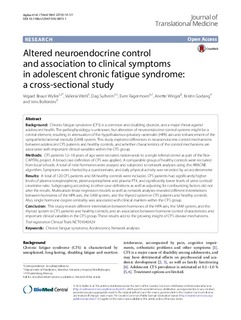| dc.description.abstract | Background
Chronic fatigue syndrome (CFS) is a common and disabling disorder, and a major threat against adolescent health. The pathophysiology is unknown, but alteration of neuroendocrine control systems might be a central element, resulting in attenuation of the hypothalamus–pituitary–adrenalin (HPA) axis and enhancement of the sympathetic/adrenal medulla (SAM) system. This study explored differences in neuroendocrine control mechanisms between adolescent CFS patients and healthy controls, and whether characteristics of the control mechanisms are associated with important clinical variables within the CFS group.
Methods
CFS patients 12–18 years of age were recruited nation-wide to a single referral center as part of the NorCAPITAL project. A broad case definition of CFS was applied. A comparable group of healthy controls were recruited from local schools. A total of nine hormones were assayed and subjected to network analyses using the ARACNE algorithm. Symptoms were charted by a questionnaire, and daily physical activity was recorded by an accelerometer.
Results
A total of 120 CFS patients and 68 healthy controls were included. CFS patients had significantly higher levels of plasma norepinephrine, plasma epinephrine and plasma FT4, and significantly lower levels of urine cortisol/creatinine ratio. Subgrouping according to other case definitions as well as adjusting for confounding factors did not alter the results. Multivariate linear regression models as well as network analyses revealed different interrelations between hormones of the HPA axis, the SAM system, and the thyroid system in CFS patients and healthy controls. Also, single hormone degree centrality was associated with clinical markers within the CFS group.
Conclusion
This study reveals different interrelation between hormones of the HPA axis, the SAM system, and the thyroid system in CFS patients and healthy controls, and an association between hormone control characteristics and important clinical variables in the CFS group. These results add to the growing insight of CFS disease mechanisms. | en |
